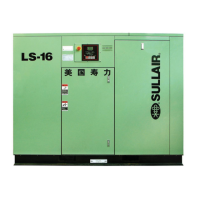Section 6
OPERATION- SUPERVISOR II
34
6.8 PURPOSE OF CONTROLS - SUPERVISOR II (CONTINUED)
CONTROL OR INDICATOR PURPOSE
MINIMUM PRESSURE/CHECK VALVE Maintains minimum of 50 psig (3.4 bar)inthecompres-
sor sump. Valve piston restricts receiver air discharge
from receiver/sump when pressure falls to 50 psig (3.4
bar). Also incorporated in this valve is a terminal check
valve which prevents line pressure backflow into the
sump during unload conditions and after shutdown.
PRESSURE RELIEF VALVE Protects compressor by venting compressed airin ex-
cess of 200 psig (13.8 bar) to atmosphere.
MODULATING INLET VALVE Regulates the amount of air allowed to enter the air
compressor. This regulation is determined by the
amount of air being used at the service line. Also acts
as a check valve to prevent reverse compressor rota-
tion at shut down.
SOLENOID VALVE Bypasses the pressure regulator valve causing the in-
let valve to close when the compressor reaches maxi-
mum operating pressure. Also activates blowdown
valve.
WATER REGULATING VALVE Regulates the amount of cooling water used in the
(water--cooled only) cooler to keep the compressor running at a normal oper-
ating temperature of 170
_
F(77
_
C).
6.9 SUPERVISOR II OUTPUT RELAYS
RELAY OPERATION
RUN RELAY (K1) Contact closure energizes the compressor starter.
*--DELTA (K2) A timed contact used to provide wye--delta transition
time.
UNLOAD/LOAD (K3) Controls ON LOAD/OFF LOAD operation of the load
control solenoid valve.
COMMON FAULT (K4) May be used to provide remote indication of any pre--
alarm, maintenance or fault shutdown condition.
DRAIN VALVE (K5) Controls optional solenoid valve to provide automatic
condensate removal.
FULL LOAD/MODULATE (K6) Used with optional sequencing feature.
NOTE: All output relays will handle eight (8) amps at 120/240 VAC.
6.10 INITIAL START-UP PROCEDURE- SUPERVISOR
II
The following procedureshouldbeusedto make the
initial start--up of the compressor.
1. Read the preceding pages of this manual thor-
oughly.
2. Jog motor to check for correct rotation of motor
( r efer t o Sec tion 4.8) .
3. Be sure that all preparations and checks de-
scribed in the Installation Section have been
made.
4. Open the shut--off valve to the service line.
5. Check for possible leaks in piping.
6. Slowly close the shut--off valve to assure proper
nameplate pressure unload setting is correct.
The compressor will unload at nameplate pres-

